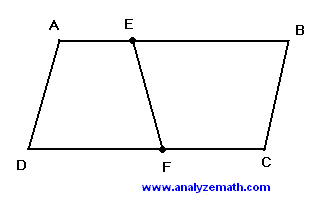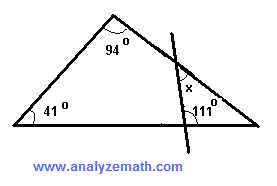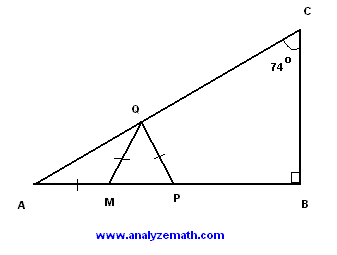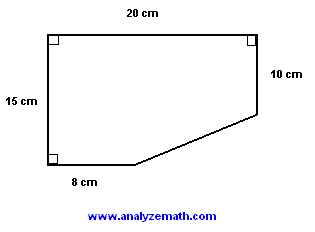Geometry Problems and Questions with Answers for Grade 9
Explore a variety of Grade 9 geometry problems and questions, complete with solutions. These problems cover key topics such as calculating the areas and perimeters of triangles, rectangles, parallelograms, squares, and other geometric shapes. Additionally, several problems focus on determining angles. Some of these problems are more challenging and require a solid understanding of geometric principles before attempting a solution. For a deeper understanding, detailed solutions and step-by-step explanations are provided to guide you through the process.
Problem 1
Angles \( A \) and \( B \) are complementary and the measure of angle \( A \) is twice the measure of angle \( B \). Find the measures of angles \( A \) and \( B \),
Let \( A \) be the measure of angle A and B be the measure of angle \( B \). Hence \[ A = 2B \] Angles \( A \) and \( B \) are complementary; hence \[ A + B = 90^\circ \] But \( A = 2B \); hence \[ 2B + B = 90 \] \[ 3B = 90 \] \[ B = 90 / 3 = 30^\circ \] \[ A = 2B = 60^\circ \]
Problem 2
\( ABCD \) is a parallelogram such that \( AB \) is parallel to \( DC \) and \( DA \) parallel to \( CB \). The length of side \( AB \) is \( 20 \) cm. \( E \) is a point between \( A \) and \(B \) such that the length of \( AE \) is \( 3 \) cm. \( F \) is a point between points \( D \) and \( C \). Find the length of \( DF \) such that the segment \( EF \) splits the parallelogram in two regions with equal areas.
 .
.
Let \( A_1 \) be the area of the trapezoid \( AEFD \). Thus, \[ A_1 = \frac{1}{2} h (AE + DF) = \frac{1}{2} h (3 + DF) \] where \( h \) is the height of the parallelogram.
Similarly, let \( A_2 \) be the area of the trapezoid \( EBCF \), which is given by \[ A_2 = \frac{1}{2} h (EB + FC). \] We also know that \[ EB = 20 - AE = 17, \quad FC = 20 - DF. \] Substituting these values into the equation for \( A_2 \), we get \[ A_2 = \frac{1}{2} h (17 + 20 - DF) = \frac{1}{2} h (37 - DF). \] For line segment \( EF \) to divide the parallelogram into two equal-area regions, we set the areas \( A_1 \) and \( A_2 \) equal: \[ \frac{1}{2} h (3 + DF) = \frac{1}{2} h (37 - DF). \] Multiplying both sides by 2 and dividing by \( h \), we simplify to \[ 3 + DF = 37 - DF. \] Solving for \( DF \), we get \[ 2DF = 37 - 3, \] \[ 2DF = 34, \] \[ DF = 17 \text{ cm}. \]
Problem 3
Find the measure of angle \( A \) in the figure below.
 .
.
In a triangle, the sum of the interior angles is always \(180^\circ\). The first interior angle (bottom left) is supplementary to an angle measuring \(129^\circ\). Since supplementary angles sum to \(180^\circ\), we find: \[ \text{First Interior Angle} = 180^\circ - 129^\circ = 51^\circ \] Similarly, the second interior angle (bottom right) is supplementary to an angle measuring \(138^\circ\): \[ \text{Second Interior Angle} = 180^\circ - 138^\circ = 42^\circ \] Determine the third interior angle \( A \) using the angle sum property of a triangle: \[ A + 51^\circ + 42^\circ = 180^\circ \] Solving for \( A \): \[ A = 180^\circ - 51^\circ - 42^\circ = 87^\circ \] Thus, the third interior \( A \) angle of the triangle is \(87^\circ\).
Problem 4
\( A B C \) is a right triangle. \( AM \) is perpendicular to \( BC \). The size of angle \( ABC \) is equal to \( 55^\circ \). Find the size of angle \( MAC \).
 .
.
The sum of all angles in \( \triangle ABC \) is equal to \( 180^\circ \). Hence, \[ \angle ABC + \angle ACM + 90^\circ = 180^\circ \] Substituting \( \angle ABC = 55^\circ \) \[ 55^\circ + \angle ACM + 90^\circ = 180^\circ \] and solving for \( \angle ACM \): \[ \angle ACM = 180^\circ - 90^\circ - 55^\circ = 35^\circ \] Similarly, the sum of all angles in \( \triangle AMC \) is equal to \( 180^\circ \). Hence, \[ \angle MAC + \angle ACM + 90^\circ = 180^\circ \] Substituting \( \angle ACM = 35^\circ \) and solving for \( \angle MAC \): \[ \angle MAC = 180^\circ - 90^\circ - 35^\circ = 55^\circ \]
Problem 5
Find the size of angle MBD in the figure below.
 .
.
The sum of all angles in triangle \( \triangle AMC \) is equal to \( 180^\circ \). Hence,
\[ 56^\circ + 78^\circ + \angle AMC = 180^\circ \] \[ \angle AMC = 180^\circ - 56^\circ - 78^\circ = 46^\circ \]Angles \( \angle AMC \) and \( \angle DMB \) are vertical angles and are therefore equal. Hence,
\[ \angle DMB = 46^\circ \]The sum of the angles in triangle \( \triangle DMB \) is equal to \( 180^\circ \). Hence,
\[ \angle MBD + \angle DMB + 62^\circ = 180^\circ \]Substituting \( \angle DMB = 46^\circ \) and solving for \( \angle MBD \):
\[ \angle MBD + 46^\circ + 62^\circ = 180^\circ \] \[ \angle MBD = 180^\circ - 46^\circ - 62^\circ = 72^\circ \]Problem 6
The size of angle AOB is equal to 132 degrees and the size of angle COD is equal to 141 degrees. Find the size of angle DOB.
 .
.
The given angle \( \angle AOB = 132^\circ \) is the sum of angles \( \angle AOD \) and \( \angle DOB \). Hence, \[ \angle AOD + \angle DOB = 132^\circ \quad \text{(Equation 1)} \] Similarly, the given angle \( \angle COD = 141^\circ \) is the sum of angles \( \angle COB \) and \( \angle BOD \). Thus, \[ \angle COB + \angle DOB = 141^\circ \quad \text{(Equation 2)} \] Adding both equations: \[ (\angle AOD + \angle DOB) + (\angle COB + \angle DOB) = 132^\circ + 141^\circ \] Since the sum of angles \( \angle AOD \), \( \angle DOB \), and \( \angle COB \) forms a straight line, we have: \[ \angle AOD + \angle DOB + \angle COB = 180^\circ \] Substituting this into the equation above: \[ 180^\circ + \angle DOB = 132^\circ + 141^\circ \] Solving for \( \angle DOB \): \[ \angle DOB = 273^\circ - 180^\circ = 93^\circ \] Thus, \( \angle DOB \) is \( 93^\circ \).
Problem 7
Find the size of angle \( x \) in the figure.
 .
.
The interior angle of the quadrilateral \( ABB'A' \) that is supplementary to \( x \) is given by:
\[ \angle BB'A' = 180^\circ - x \] Similarly, the interior angle of the \( ABB'A' \) that is supplementary to \( 111^\circ \) is: \[ \angle B'A'A = 180^\circ - 111^\circ = 69^\circ \] Since the sum of all interior angles of a quadrilateral \( ABB'A' \) is \( 360^\circ \), we set up the equation: \[ 41^\circ + 94^\circ + (180^\circ - x) + 69^\circ = 360^\circ \] Solving for \( x \): \[ 384^\circ - x = 360^\circ \] \[ x = 384^\circ - 360^\circ = 24^\circ \] Thus, angle \( x \) measures \( 24^\circ \).Problem 8
The rectangle below is made up of 12 congruent (same size) squares. Find the perimeter of the rectangle if the area of the rectangle is equal to 432 square cm.
 .
.
If the total area of the rectangle is 432 square centimeters, then the area of one small square is given by: \[ \frac{432}{12} = 36 \text{ cm}^2 \] Let \( x \) be the side length of one small square. Since the area of a square is given by \( x^2 \), we have: \[ x^2 = 36 \] Solving for \( x \): \[ x = 6 \text{ cm} \] The length (\( L \)) of the rectangle is four times the side length of the square, and the width (\( W \)) is three times the side length: \[ L = 4 \times 6 = 24 \text{ cm}, \quad W = 3 \times 6 = 18 \text{ cm} \] The perimeter (\( P \)) of the rectangle is calculated as: \[ P = 2(L + W) = 2(24 + 18) = 84 \text{ cm} \]
Problem 9
\( ABC \) is a right triangle with the size of angle \( ACB \) equal to \(74^\circ \). The lengths of the sides \( AM \), \( MQ \) and \( QP \) are all equal. Find the measure of angle \( \angle QPB \).
 .
.
Angle \( \angle CAB \) in the right triangle \( \triangle ACB \) is given by: \[ \angle CAB = 90^\circ - 74^\circ = 16^\circ \] which gives \[ \angle QAM = \angle CAB = 16^\circ \] Since sides \( AM \) and \( MQ \) are equal in length, triangle \( \triangle AMQ \) is isosceles. Therefore: \[ \angle AQM = \angle QAM = 16^\circ \] The sum of all interior angles in triangle \( \triangle AMQ \) is \( 180^\circ \). Hence: \[ 16^\circ + 16^\circ + \angle AMQ = 180^\circ \] Solving for \( \angle AMQ \): \[ \angle AMQ = 180^\circ - 32^\circ = 148^\circ \] Angle \( \angle QMP \) is supplementary to \( \angle AMQ \). Hence: \[ \angle QMP = 180^\circ - \angle AMQ = 180^\circ - 148^\circ = 32^\circ \] Since the lengths of \( QM \) and \( QP \) are equal, triangle \( \triangle QMP \) is isosceles. Therefore, \( \angle QPM \) is equal in size to \( \angle QMP \), hence: \[ \angle QPM = \angle QMP = 32^\circ \] Angle \( \angle QPB \) is supplementary to \( \angle QPM \). Hence: \[ \angle QPB = 180^\circ - \angle QPM = 180^\circ - 32^\circ = 148^\circ \]
Problem 10
Find the area of the given shape.
 .
.
The area of the given shape can be found by subtracting the area of the right triangle from the area of the large rectangle (as shown in the figure below).

The sides of the red triangle are given by: \[ 15 - 10 = 5 \, \text{cm} \quad \text{and} \quad 20 - 8 = 12 \, \text{cm} \] The area of the given shape is calculated as: \[ \text{Area} = \text{area of the rectangle} - \text{area of the red triangle} \] \[ = 20 \times 15 - \frac{1}{2} \times 12 \times 5 = 270 \, \text{cm}^2 \]
Problem 11
Find the area of the shaded region.
 .
.
The area of the shaded region can be calculated by subtracting the area of the rectangle at the top left (white) from the area of the large rectangle.
Dimensions of the rectangle at the top left: \[ \text{Length} = 30 - 8 = 22 \, \text{cm}, \quad \text{Width} = 15 - 4 = 11 \, \text{cm} \] Area of the shaded region: \[ \text{Area of given shape} = \text{area of the large rectangle} - \text{area of the rectangle at top left (white)} \] \[ = 30 \times 15 - 22 \times 11 = 208 \, \text{cm}^2 \]
Problem 12
The vertices of the inscribed (inside) square bisect the sides of the second (outside) square. Find the ratio of the area of the outside square to the area of the inscribed square.
 .
.
Let \( 2x \) be the length of the side of the large square (see the figure below).
